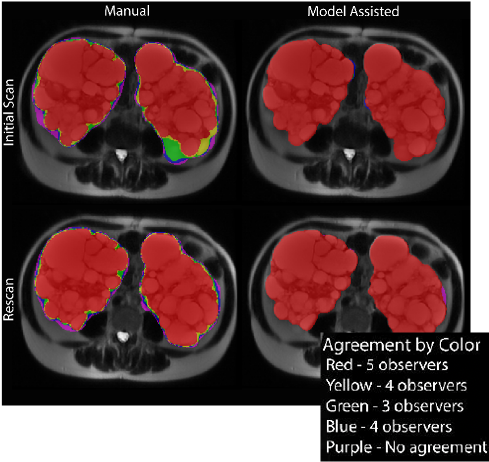Principal Investigator:
Martin Prince, Professor of Radiology
Background & Unmet Need
- Organ volume is an important biomarker for diagnosing and tracking response to therapy in several diseases including Autosomal Dominant Polycystic Kidney Disease (ADPKD)
- Accurate measurement of kidney volume is essential for ADPKD patients since this disease progresses slowly and patients may need to wait for more than a year to assess response to therapy
- Currently, the main method of measuring total kidney volume (TKV) for ADPKD requires manual tracing of the kidney boundaries on MRI or CT scans for each imaging slice
- This process is not only tedious, but also subject to variability between observers, leading to random errors up to 11%
- Unmet Need: Methods for measuring organ volume which are faster, more accurate, and more reproducible
Technology Overview
- The Technology:
- An automated, deep learning-based method for measuring organ volumes using averages to reduce variability
- Organ volume is calculated using a 2D U-net model trained on pulsed sequences of MRI images
- Patients are scanned using T2-weighted fast spin echo (axial, coronal), steady state free precession (axial, coronal), and T1-weighted 3D gradient echo (axial)
- These automated measurements are averaged for an improved and reproducible measurement of TKV
- PoC Data: Automated measurements were calculated significantly faster than manual measurements (2:49 mins vs 11:34 mins), but did not statistically differ from the manual calculation
- Averaging measurements from the five models significantly reduced variability to an average of 2.5% (compared to an average of 5.9% for five manual observers)
Technology Applications
- Automatic measurement of kidney volume to track disease progression in ADPKD
- Predict risk of developing end-stage kidney disease and determine eligibility for tolvaptan therapy
- Track disease progression and treatment response in other indications involving organ enlargement, such as splenomegaly and hepatomegaly
Technology Advantages
- More reproducible and faster measurement of organ volume
- Enables organ volume measurement more frequently and from multiple orientations
- Lower risk of intra- and inter-observer error

Contours of kidney volume drawn manually are more reproducible using model assisted labelling.
Publications
Resources
Intellectual Property
Patents
- US Application Filed
Cornell Reference
- 10591
Contact Information

For additional information please contact
Donna Rounds
Associate Director, Business Development and Licensing
Phone: (646) 780-8775
Email: djr296@cornell.edu

